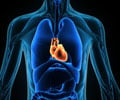Cardiomyopathy is dangerous as it can catch up unawares, leading to heart failure and even death.
Cardiomyopathy is dangerous as it can catch up unawares, leading to heart failure and even death. This disease is normally triggered by high blood pressure, heart valve or arterial diseases and congenital heart defects, but it can also be sparked by certain viral infections in the bloodstream.
In a paper to be published in the July issue of the journal Nature Structural and Molecular Biology, a Rutgers-Newark researcher and his coworkers reveal that they have identified a possible mechanism used by an important motor protein which acts as a catalyst that enables bacteria outside the human body to travel through the blood stream and infect organs such as the heart.The findings were published by Rutgers-Newark Chemistry Assistant Professor Charalampos Kalodimos and his coworkers, in the article, "Disorder-order folding transitions underlie catalysis in the helicase motor of SecA." Identifying the way this motor protein works is significant because it may lead to the development of new pharmacological therapies which can target and kill the bacteria to prevent or minimize damage to the heart muscle. The results follow nearly two years of research funded by a $300,000 American Heart Association (AHA) grant. The AHA agreed to support Kalodimos's research because he is focusing on specific bacteria that cause cardiovascular diseases in both adults and children.
Using high-resolution NMR Spectroscopy technology, Kalodimos identified the mechanism of function of motor protein SecA, which uses chemical energy and converts it into mechanical energy. SecA is present only in bacteria and is not found in humans. SecA uses mechanical energy to secrete toxins and other harmful proteins to the exterior of the bacterium cell.
Once a bacterium infects a human or a host, some bacteria will use the SecA system to secrete specific bacteria proteins into the human body causing infections or diseases. Recent advances in NMR Spectroscopy allowed Kalodimos and his coworkers to observe how proteins work in motion. NMR spectroscopy exploits the interaction of radio waves with matter to give scientists a moving picture of molecular structures within the body. The methodology used in Kalodimos group provides researchers with detailed, moving pictures rather than static images produced by other technologies such as X-ray crystallography. Kalodimos likens the motor protein and bacteria activity he has identified to the United State Postal Service's zip code system used to process mail and directs it to its final destination.
"A city as a large as New York City has several different zip codes and a central post office must be present to scan and read these zip codes so the letters can reach their intended destinations," Kalodimos explains. "Proteins have one signal that operates similar to a zip code. The protein "zip code" is read or scanned by some specific protein or large protein machineries. These machineries are needed to transport the protein to the correct compartment within a cell."
He explained that once a bacterium infects a host or human, certain bacteria will use SecA to read the "zip code" system to secrete specific bacteria proteins into the human body.
Advertisement
Source :Eureka Alert
Advertisement











